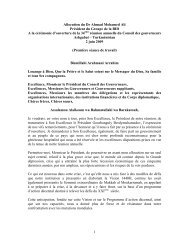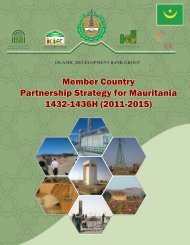Disbursement Procedures - Islamic Development Bank
Disbursement Procedures - Islamic Development Bank
Disbursement Procedures - Islamic Development Bank
Create successful ePaper yourself
Turn your PDF publications into a flip-book with our unique Google optimized e-Paper software.
- Participation in profit and loss sharing, since return is not guaranteed in an<br />
<strong>Islamic</strong> transaction.<br />
1.8 The IDB does not borrow from the market and its operations are sustained by<br />
share-holders capital, retained earnings and funds generated internally through its foreign<br />
trade and project financing operations. The IDB has no non-regional members. The IDB is<br />
an institution established by the Ummah, for the Ummah and operated and managed by<br />
the Ummah. The IDB finances trade and development projects both for the public and<br />
private sectors, finances large and medium sized projects and small enterprises in the<br />
member countries.<br />
1.9 In non-member countries the IDB supports <strong>Islamic</strong> communities by providing<br />
scholarships and training facilities. Through the <strong>Islamic</strong> Research Training Institute (IRTI),<br />
the IDB conducts research on <strong>Islamic</strong> topics having modern day relevance. The IDB also<br />
mobilizes technical capabilities within member countries in order to promote exchange of<br />
expertise and experience. Science and Technology development are in the forefront of<br />
the strategic agenda of the IDB which forms an integral part of project financing.<br />
Additionally, the IDB provides merit scholarships for high technology to scholars for<br />
pursuing doctorate programme and post-doctoral research in centers of excellence in the<br />
world.<br />
1.10 Through its <strong>Islamic</strong> Corporation for the Insurance of Investments and Export Credit<br />
(ICIEC), the IDB provides, in accordance with the principles of Shari'ah, export credits,<br />
insurance to cover non-payment of export receivables resulting from commercial (buyers)<br />
and non-commercial (country) risks.<br />
Modes of IDB Financing<br />
1.11 The <strong>Bank</strong> finances projects from its Ordinary Capital Resources (OCR) by way of<br />
interest-free loan or soft loan, under the modes of financing of loans, installment sale,<br />
technical assistance, equity participation, profit sharing, istisna'a and lines of financing<br />
extended to NDFIs. A brief explanation of the applicable modes of financing is given<br />
below:<br />
1.11.1 Loan<br />
This mode of financing is used for projects expected to have a significant socioeconomic<br />
developmental impact, with a long implementation period and which may not be<br />
revenue-generating. Loans are given to governments or public institutions mainly in the<br />
Least Developed Member Countries (LDMCs) for implementation of social infrastructure<br />
projects.<br />
At the moment the current policy is that the <strong>Bank</strong> charges a modest service fee, not<br />
exceeding 2.5%, to recover part of the administrative costs incurred in project<br />
identification, appraisal and supervision. In addition, the loans provided by the <strong>Bank</strong><br />
include a grace period of 3-7 years and repayment is spread over a period of 15-25 years.<br />
These projects are usually given maximum grace and repayment periods.<br />
1.11.2 Leasing<br />
This is a medium term mode of financing for rental of capital equipments and other<br />
fixed assets such as plant, machinery and equipment for industrial, agro-industrial,<br />
infrastructure, transport, etc., both for public and private sectors. Lease financing is also






